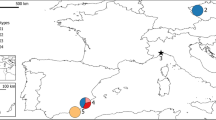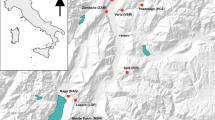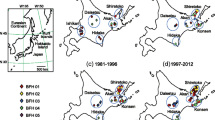Abstract
Monitoring the loss of genetic diversity in wild populations after a bottleneck event is a priority in conservation and management plans. Here, we used diverse molecular markers to search for signatures of demographic bottlenecks in two wolf populations; an isolated population from the Iberian Peninsula and a non-isolated population from European Russia. Autosomal, mtDNA and Y-chromosomal diversity and the effective population size (Ne) were significantly lower in the Iberian population. Neutrality tests using mtDNA sequences, such as R2, Fu and Li’s F*, Tajima’s D and Fu’s Fs, were positively significant in the Iberian population, suggesting a population decline, but were not significant for the Russian population, likely due to its larger effective population size. However, three tests using autosomal data confirmed the occurrence of the genetic bottleneck in both populations. The M-ratio test was the only one providing significant results for both populations. Given the lack of consistency among the different tests, we recommend using multiple approaches to investigate possible past bottlenecks. The small effective population size (about 50) in the Iberian Peninsula compared to the presumed extant population size could indicate that the bottleneck was more powerful than initially suspected or an overestimation of the current population. The risks associated with small effective population sizes suggest that the genetic change in this population should be closely monitored in the future. On the other hand, the relatively small effective population size for Russian wolves (a few hundred individuals) could indicate some fragmentation, contrary to what is commonly assumed.




Similar content being viewed by others
References
Álvares FI, Barroso JC, Blanco J et al. (2005) Wolf status and conservation in the Iberian Peninsula. International Congress Frontiers of Wolf Recovery. Colorado Springs, Colorado, October 2005
Aspi J, Roininen M, Ruokonen M, Kojola I, Vilà C (2006) Genetic diversity, population structure, effective population size and demographic history of the Finnish wolf population. Mol Ecol 15:1561–1579
Aspi J, Roininen M, Kiiskilä J, Ruokonen M, Kojola I, Bljudnik L, Danilov P, Heikkinen S, Pulliainen E (2009) Genetic structure of the northwestern Russian wolf populations and gene flow between Russia and Finland. Conserv Genet 10:815–826
Bandelt HJ, Forster P, Rohl A (1999) Median-joining networks for inferring intraspecific phylogenies. Mol Biol Evol 16:37–48
Bannasch DL, Bannasch MJ, Ryun JR, Famula TR, Pedersen NC (2005) Y chromosome haplotype analysis in purebred dogs. Mamm Genome 16:273–280
Belkhir K, Borsa P, Goudet J, Chikhi L, Bonhomme F (1999) GENETIX, Logiciel sous Windows TM pour la Génétique des Populations. Laboratoire Génôme et Populations, CNRS UPR 9060. Université de Montpellier II, Montpellier, France
Benzecri J (1973) L’Analyse des Données. Tome I: la Taxinomie; Tome II: l’Analyse des Correspondances. Dunod Press, Paris
Bibikov DI (1994) Wolf problem in Russia. Lutreola 3:10–14
Bibikov DI, Ovsyannikov NG, Filimonov AN (1983) The status and management of the wolf population in the USSR. Acta Zoologica Fennica 174:269–271
Boitani L (2003) Wolf conservation and recovery. In: Mech LD, Boitani L (eds) Wolves. Behavior, ecology and conservation. University of Chicago Press, Chicago, pp 317–340
Borisov BP, Gibet LA, Gubar JP et al. (1992) Senior management of the hunting facilities economy at RSFSR. The central research laboratory of the hunting facilities economy and reserves. Moscow (in Russian)
Busch JD, Waser PM, DeWoody JA (2007) Recent demographic bottlenecks are not accompanied by a genetic signature in banner-tailed kangaroo rats (Dipodomys spectabilis). Mol Ecol 16:2450–2462
Carlsson J (2008) Effects of microsatellite null alleles on assignment testing. J Hered 99:616–623
Carmichael LE, Krizan J, Nagy JA, Fuglei E, Dumond M, Johnson D, Veitch A, Berteaux D, Strobeck C (2007) Historical and ecological determinants of genetic structure in artic canids. Mol Ecol 16:3466–3483
Cornuet JM, Luikart G (1996) Description and power analysis of two tests for detecting recent population bottlenecks from allele frequency data. Genetics 144:2001–2014
England PR, Luikart G, Waples RS (2010) Early detection of population fragmentation using linkage disequilibrium estimation of effective population size. Conserv Genet 11:2425–2430
Evanno G, Regnaut S, Goudet J (2005) Detecting the number of clusters of individuals using the software structure: a simulation study. Mol Ecol 14:2611–2620
Falush D, Stephens M, Pritchard JK (2007) Inference of population structure using multilocus genotype data: dominant markers and null alleles. Mol Ecol Notes 7:574–578
Fay JC, Wu CI (1999) A human population bottleneck can account for the discordance between patterns of mitochondrial versus nuclear DNA variation. Mol Biol Evol 16:1003–1005
Flagstad ∅, Walker CW, Vilà C, Sundqvist AK, Fernholm B, Hufthammer AK, Wiig ∅, Koyola I, Ellegren H (2003) Two centuries of the Scandinavian wolf population: patterns of genetic variability and migration during an era of dramatic decline. Mol Ecol 12:869–880
Francisco LV, Langston AA, Mellersh CS, Neal CL, Ostrander EA (1996) A class of highly polymorphic tetranucleotide repeats for the canine genetic mapping. Mamm Genome 7:359–362
Frankham R, Ballou JD, Briscoe DA (2002) Introduction to conservation genetics. Cambridge University Press, Cambridge
Fredholm M, Wintero AK (1995) Variation of short tandem repeats within and between species belonging to the Canidae family. Mamm Genome 6:11–18
Garza JC, Williamson EG (2001) Detection of reduction in population size using data from microsatellite loci. Mol Ecol 10:305–318
Goudet J (2000) FSTAT version 2.9.3.2. Computer package for PCs. Institute of Ecology, Lausane, Switzerland
Grande del Brío R (1984) El lobo Ibérico Biología y mitología. Editorial Hermann Blume, Madrid
Gubar JP (1996) The wolf in Russia caught between hunters and environmentalists. Russ Conserv News 8:19–20
Guo S, Thompson E (1992) Performing the exact test of Hardy–Weinberg proportion for multiple alleles. Biometrics 48:361–372
Hudson RR, Slatkin M, Maddison WP (1992) Estimation of levels of gene flow from DNA sequence data. Genetics 132(2):583–589
International Union for Conservation of Nature (IUCN) (1973) Red list of threatened species. http://www.iucnredlist.org/
Keller LF, Jeffery KJ, Arcese P et al (2001) Immigration and the ephemerality of a natural population bottleneck: evidence from molecular markers. Proc R Soc Lond 268:1387–1394
Kimura M (1983) The neutral theory of molecular evolution. Cambridge University Press, Cambridge, UK
Koblmüller S, Nord M, Wayne RK, Leonard JA (2009) Origin and status of the Great Lakes wolf. Mol Ecol 18:2313–2326
Lomanov IK, Borisov BP, Bolodnina OA et al (1995) The hunting animals of Russia. Department on protection and rational use. State service of the account of the hunting resources, Moscow (in Russian)
Lomanov IK, Borisov BP, Bolodnina OA et al (2000) The hunting animals of Russia. State service of the account of the hunting resources. Ministry of agriculture of the Russian Federation, Moscow (in Russian)
Lucchini V, Galov A, Randi E (2004) Evidence of genetic distinction and long-term population decline in wolves (Canis lupus) in the Italian Apennines. Mol Ecol 13:523–536
Luikart G, Cornuet JM (1997) Empirical evaluation of a test for identifying recently bottlenecked populations from allele frequency data. Conserv Biol 12:228–237
Luikart G, Allendorf FW, Cornuet JM, Sherwin WB (1998) Distortion of allele frequency distributions provides a test for recent population bottlenecks. J Hered 89:238–247
Musiani M, Leonard JA, Cluff HD, Gates CC, Mariani S, Paquet PC, Vilà C, Wayne RK (2007) Differentiation of tundra/taiga and boreal coniferous forest wolves: genetics, coat colour and association with migratory caribou. Mol Ecol 16:4149–4170
Ostrander EA, Mapa FA, Yee M, Rine J (1995) One hundred and one simple sequence repeats-based markers for the canine genome. Mamm Genome 6:192–195
Ovsyanikov N, Bibikov DI, Bologov VV (1998) Battling with wolves: Russia’s decades-old struggle to manage its fluctuating wolf population. Int Wolf Center Publ 8(1):16–19
Peakall R, Smouse PE (2006) GENALEX 6: genetic analysis in Excel. Population genetic software for teaching and research. Mol Ecol Notes 6:288–295
Peel D, Ovenden JR, Peel SL (2004) NeEstimator: software for estimating effective population size, version 1.3. Queensland Government, Department of Primary Industries and Fisheries, Australia
Pilot M, Jedrzejewski W, Branicki W et al (2006) Ecological factors influence population genetic structure of European grey wolves. Mol Ecol 15:4533–4553
Ramírez O, Altet L, Enseñat C, Vilà C, Sánchez A, Ruiz A (2006) Genetic assessment of the Iberian wolf Canis lupus signatus captive breeding program. Conserv Genet 7:861–878
Ramos-Onsins SE, Rozas J (2002) Statistical properties of new neutrality tests against population growth. Mol Biol Evol 19(12):2092–2100
Randi E, Lucchini V, Christensen MF et al (2000) Mitochondrial DNA variability in Italian and East European wolves: detecting the consequences of small population size and hybridization. Conserv Biol 14:464–473
Reed DH, Briscoe DA, Frankham R (2002) Inbreeding and extinction: the effect of environmental stress and lineage. Conserv Genet 3:301–307
Rozas J, Sánchez-DelBarrio JC, Messeguer X, Rozas R (2003) DNASP, DNA polymorphism analyses by the coalescent and other methods. Bioinformatics 19:2496–2497
Saccheri IJ, Wilson IJ, Nichols RA, Bruford MW, Brakefield PM (1999) Inbreeding of bottlenecked butterfly populations: estimation using the likelihood of changes in marker allele frequencies. Genetics 151:1053–1063
Sastre N, Francino O, Lampreave G et al. (2007) Seguimiento del lobo (Canis lupus) en Cataluña mediante el análisis genético de muestras no invasivas. In: XXXVI Congreso de la Sociedad Española de Genética. SEG 2007, León, p 127
Sastre N, Francino O, Lampreave G et al (2009) Sex identification of wolf (Canis lupus) using non-invasive simples. Conserv Genet 10:555–558
Schneider S, Roessli D, Excoffier L (2006) Arlequin ver 3.01: An integrated software package for population genetics data analysis. Computational and Molecular Population Genetics Lab, University of Berne, Switzerland
Sundqvist AK, Ellegren H, Olivier M, Vilà C (2001) Y chromosome haplotyping in Scandinavian wolves (Canis lupus) based on microsatellite markers. Mol Ecol 10:1959–1966
Valière N, Fumagalli L, Gielly L et al (2003) Long-distance wolf recolonization of France and Switzerland inferred from non-invasive genetic sampling over a period of 10 years. Anim Conserv 6:83–92
Valverde JA (1971) El lobo español. Montes 159:228–241
Van Oosterhout C, Hutchinson WF, Wills DP, Shipley P (2004) Micro-checker: software for identifying and correcting genotyping errors in microsatellite data. Mol Ecol Notes 4:535–538
Vilà C (2010) Viabilidad de las poblaciones ibéricas de lobos. Enseñanzas de la genética para la conservación. In: Fernández-Gil A, Álvares F, Vilà C, Ordiz A (eds) Los lobos de la Península Ibérica. Propuestas para el diagnóstico de sus poblaciones. ASCEL, Palencia, Spain, pp 157–171
Vilà C, Amorim IR, Leonard JA et al (1999) Mitochondrial DNA phylogeography and population history of the grey wolf Canis lupus. Mol Ecol 8:2089–2103
Vilà C, Sundqvist AK, Flagstad ∅ et al (2003) Rescue of a severely bottlenecked wolf Canis lupus population by a single immigrant. Proc R Soc 270:91–97
Waples R (2006) A bias correction for estimates of effective population size based on linkage disequilibrium at unlinked gene loci. Conserv Genet 7:167–184
Weir BS, Cockerham CC (1984) Estimating F-statistics for the analysis of population structure. Evolution 38:1358–1370
Acknowledgments
Samples were moved from the Russian Federation to Spain according to CITES and VETER requirements. Animals were not killed for the purpose of this manuscript. We are grateful to the personnel from the Central Forest National Reserve (Zapovednik, Russia), especially to Pavel Koravlov, for supplying wolf tooth samples. We thank all the personnel from the “Consejería de Medio Ambiente, Junta de Castilla y León”, especially to Agustín Noriega, for supplying wolf tissue samples. Thanks are due also to Sebastian Ramos-Onsins and Joaquim Casellas for valuable comments on the analyses, to Miki Monguilod for IT support, to Gary Walker for linguistic revision and two anonymous reviewers for helpful comments on the manuscript. Carles Vilà work was supported by the “Programa para la Captación del Conocimiento para Andalucía” (Andalusian Government, Spain). Financial support was provided by the “Servei Veterinari de Genètica Molecular” (SVGM).
Author information
Authors and Affiliations
Corresponding author
Rights and permissions
About this article
Cite this article
Sastre, N., Vilà, C., Salinas, M. et al. Signatures of demographic bottlenecks in European wolf populations. Conserv Genet 12, 701–712 (2011). https://doi.org/10.1007/s10592-010-0177-6
Received:
Accepted:
Published:
Issue Date:
DOI: https://doi.org/10.1007/s10592-010-0177-6




